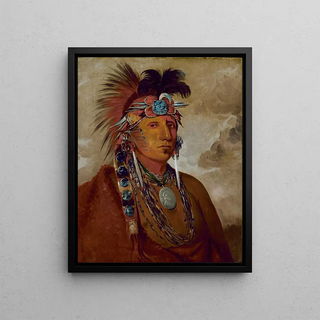Art print | Sh-Me-Ks See the wolf as a chief - George Catlin


View from behind

Frame (optional)
In the fascinating universe of art, some works transcend the simple frame to become windows into bygone eras, forgotten cultures, and profound human stories. The art print Sh-Me-Ks Voir le loup comme un chef - George Catlin is a perfect example. This painting, emblematic of the American Romantic movement, invites viewers to immerse themselves in the world of Native American tribes and to feel the intensity of their bond with nature. Through this piece, Catlin does not merely depict a frozen moment in time; he evokes a true symbiosis between man and animal, between culture and landscape. The artist manages to capture the very essence of his subjects, transporting us to a world where the spirit of nature is omnipresent.
Style and uniqueness of the work
Catlin's style is distinguished by a blend of realism and romanticism, combining meticulous attention to detail with an idealized vision of his subjects. In Sh-Me-Ks Voir le loup comme un chef, the artist uses a palette of earthy colors that evoke the ruggedness and beauty of American landscapes. The characters are portrayed with striking expressiveness, their features and postures telling stories of bravery and wisdom. The composition of the piece, where the wolf stands majestically beside its master, emphasizes a respectful hierarchy and a communion between man and animal. This painting resonates with emotional depth, bearing witness to an era when relationships between different species were imbued with respect and spirituality. Every brushstroke by Catlin seems to vibrate with lively energy, making this work a centerpiece that captures attention and imagination.
The artist and his influence
George Catlin, artist and traveler, dedicated his life to documenting Native American cultures at a time when they were threatened by colonial expansion. His work is much more than a simple collection of portraits; it is a valuable testimony to the diversity and richness of indigenous traditions. Catlin was able to translate into his canvases a romantic and idealized vision

Matte finish

View from behind

Frame (optional)
In the fascinating universe of art, some works transcend the simple frame to become windows into bygone eras, forgotten cultures, and profound human stories. The art print Sh-Me-Ks Voir le loup comme un chef - George Catlin is a perfect example. This painting, emblematic of the American Romantic movement, invites viewers to immerse themselves in the world of Native American tribes and to feel the intensity of their bond with nature. Through this piece, Catlin does not merely depict a frozen moment in time; he evokes a true symbiosis between man and animal, between culture and landscape. The artist manages to capture the very essence of his subjects, transporting us to a world where the spirit of nature is omnipresent.
Style and uniqueness of the work
Catlin's style is distinguished by a blend of realism and romanticism, combining meticulous attention to detail with an idealized vision of his subjects. In Sh-Me-Ks Voir le loup comme un chef, the artist uses a palette of earthy colors that evoke the ruggedness and beauty of American landscapes. The characters are portrayed with striking expressiveness, their features and postures telling stories of bravery and wisdom. The composition of the piece, where the wolf stands majestically beside its master, emphasizes a respectful hierarchy and a communion between man and animal. This painting resonates with emotional depth, bearing witness to an era when relationships between different species were imbued with respect and spirituality. Every brushstroke by Catlin seems to vibrate with lively energy, making this work a centerpiece that captures attention and imagination.
The artist and his influence
George Catlin, artist and traveler, dedicated his life to documenting Native American cultures at a time when they were threatened by colonial expansion. His work is much more than a simple collection of portraits; it is a valuable testimony to the diversity and richness of indigenous traditions. Catlin was able to translate into his canvases a romantic and idealized vision






